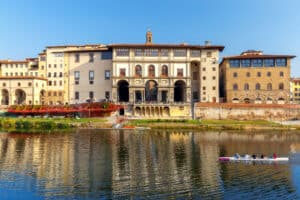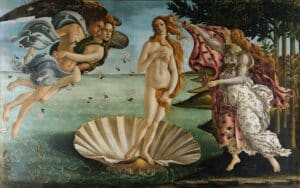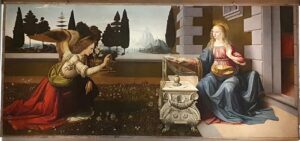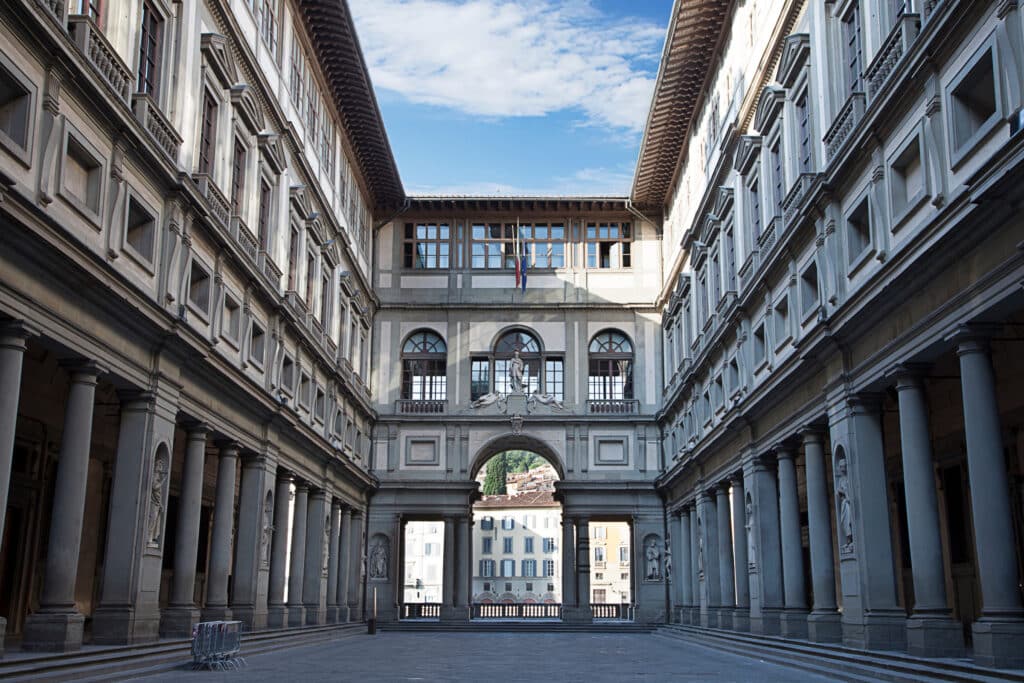
The ticket prices for the Uffizi Gallery vary depending on the time of year. In the low season (January, February, November, and December), the full price ticket for adults costs 16€. In the high season (the other months), the ticket costs 29€. The price includes the entrance ticket, skip-the-line reservation, museum map, and agency fees (4,00/5,00€ per ticket). Please note that a mandatory temporary exhibitions ticket extra charge could be added to the above ticket prices if a temporary exhibition is planned on the date you choose to visit the museum.
If you’re a young person aged 18-24 with a European passport, you can book a reduced price ticket (half). Children aged 6-18 years old (any nationality) can get a free ticket, but they will need to pay a skip-the-line fee of 4€ and an online reservation fee of 4€ euros per ticket.
The Uffizi Gallery is open from Tuesday to Sunday, from 8:15 am to 6:50 pm. The last entrance time is at 4:45 pm. The museum is closed on Mondays, 1st January, 1st May, and Christmas day. Entrance to the Uffizi Gallery is allowed every 15 minutes.
To get the most out of your visit to the Uffizi Gallery, consider taking a guided tour. Professional guides can provide valuable insights into the history, techniques, and stories behind the artworks, making your experience even more enriching and memorable. There are various tour options available, including private tours and group tours, so you can choose the one that best suits your preferences and schedule.
Introduction
Are you planning a trip to the beautiful city of Florence, Italy? If so, there’s one must-visit attraction that should be at the top of your list: the world-renowned Uffizi Gallery.
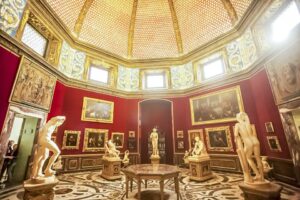
Uffizi Gallery
This art museum is not only an essential stop for art lovers, but it also offers a fascinating glimpse into Italian history and culture. In this article, we’ll take you on a journey through the Uffizi Gallery, exploring its rich history, magnificent architecture, and awe-inspiring collections. So, let’s dive in and discover the treasures that await you in this iconic Florentine institution!
History of the Uffizi Gallery
The Uffizi Gallery owes its existence to the powerful Medici family, who ruled Florence during the Renaissance. The family was known for their wealth, influence, and patronage of the arts, which led to the flourishing of culture and knowledge in the city. The story of the Uffizi Gallery begins with the Medici’s love for art and their desire to create a space where these masterpieces could be showcased and appreciated.
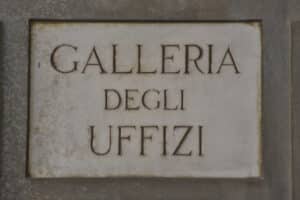
The Birth of the Uffizi Gallery
The Uffizi Gallery was founded in 1581 by Grand Duke Francesco I de’ Medici, who commissioned architect Giorgio Vasari to design a building that would house the administrative offices of the Florentine government. The building was later converted into an art gallery, displaying the vast collection of artworks amassed by the Medici family over the centuries. In 1737, Anna Maria Luisa de’ Medici bequeathed the entire collection to the city of Florence, ensuring that it would remain intact and accessible to the public for generations to come.
The Building and its Architecture
Giorgio Vasari’s Influence
Giorgio Vasari, a renowned architect, painter, and writer of the time, played a crucial role in shaping the Uffizi Gallery’s appearance. He not only designed the building, but also contributed to its interior decorations, including frescoes and architectural details. Vasari’s influence is evident in the Uffizi’s elegant, symmetrical design that perfectly complements the priceless art it houses.
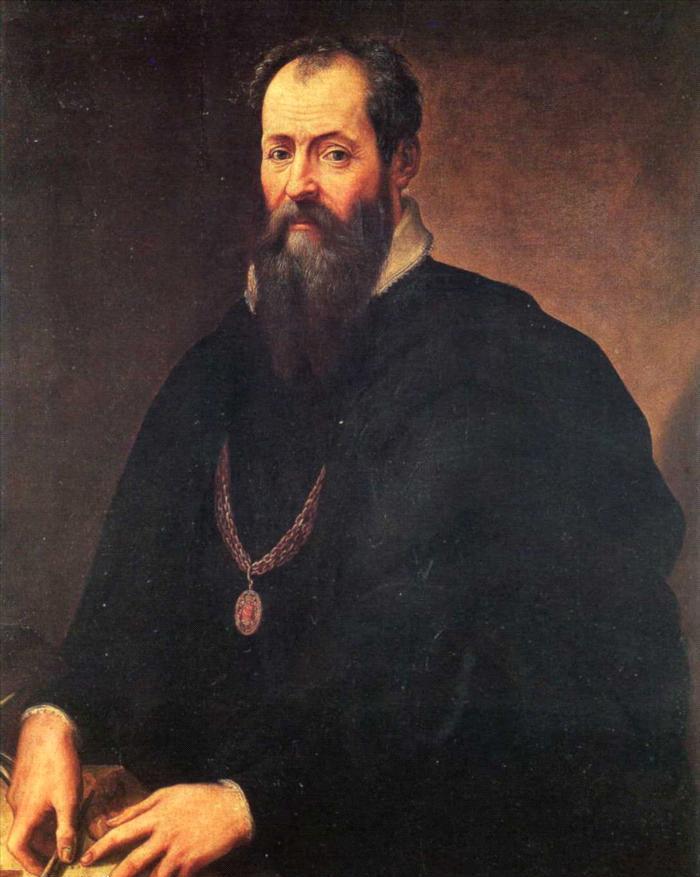
Giorgio Vasari
The Unique U-Shaped Design
The Uffizi Gallery’s building features a unique U-shaped design that encloses a large courtyard. This layout provides a spacious, open-air setting for visitors to relax and soak in the atmosphere of this historic institution. In addition, the courtyard often hosts temporary exhibitions and cultural events, adding even more charm and allure to the gallery.
Collections and Masterpieces
Italian Renaissance Art: The Uffizi Gallery is renowned for its unparalleled collection of Italian Renaissance art, which includes works by some of the most celebrated artists of the period, such as Leonardo da Vinci, Michelangelo, Raphael, and Botticelli. As you walk through the gallery, you’ll be able to witness the evolution of art during this transformative era and marvel at the ingenuity and skill of these legendary artists.
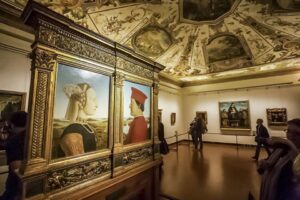
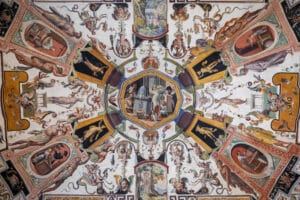
Interior of Uffizi Gallery, Details
Works by Caravaggio: In addition to its impressive Renaissance collection, the Uffizi also features several works by the Baroque master Caravaggio. His striking use of chiaroscuro, or the contrast of light and shadow, has had a lasting impact on the art world and can be seen in masterpieces such as “Medusa” and “Bacchus.”
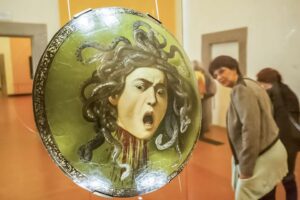
Sculpture Collection: The Uffizi Gallery is not limited to paintings; it also boasts an impressive collection of sculptures, including ancient Roman and Greek pieces as well as Renaissance masterpieces. Don’t miss the famous “Medici Venus,” a breathtaking example of Hellenistic art that is sure to leave you in awe of its exquisite craftsmanship.
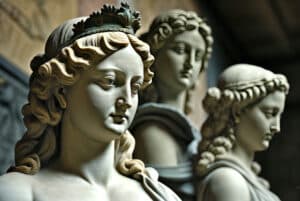
sculptures at the Uffizi Gallery in Florence, Italy
Famous Paintings
The Birth of Venus by Botticelli
The Birth of Venus by Botticelli is one of the most celebrated works of art from the Italian Renaissance. This painting, which was completed in the late 15th century, depicts the goddess Venus emerging from the sea on a seashell. It is a stunning example of the beauty and grace of Renaissance art, and it continues to captivate viewers to this day.
Before delving into the details of the painting, it is important to understand the artist behind it. Sandro Botticelli was a Florentine painter who lived from 1445 to 1510. He was a key figure in the Italian Renaissance, and his work is renowned for its beauty, elegance, and attention to detail. Botticelli was known for his portraits and religious paintings, but he also created many mythological works that were inspired by classical Greek and Roman art.
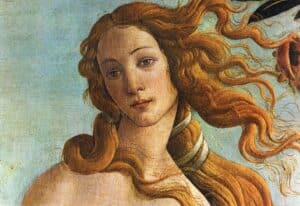
The Birth of Venus by Botticelli, detail
The Birth of Venus was painted by Botticelli in the late 1480s or early 1490s. The painting is a tempera on canvas and measures 172.5 cm × 278.9 cm. It depicts the goddess Venus, who is the Roman equivalent of the Greek goddess Aphrodite, rising from the sea on a seashell. Venus is depicted as a beautiful, naked woman, with long flowing hair that cascades down her back. She stands on the seashell, which is being carried to shore by the winds, symbolizing the birth of the goddess of love and beauty.
The Birth of Venus is a painting that is full of symbolism. Venus represents the ideal of beauty and love, and her birth represents the renewal of life and the return of spring. The seashell that she stands on is a symbol of the feminine, as it represents the womb from which she was born. The winds that carry her to shore symbolize the force of nature that gives life to all living things. The flowers that surround her are a symbol of the beauty and fragility of life, while the trees in the background represent the eternal cycle of life and death.
Primavera by Botticelli
Botticelli’s Primavera is one of the most iconic and recognizable works of art from the Renaissance period. Painted in the late 15th century, this masterpiece has captivated art lovers for centuries with its complex composition and symbolic imagery. In this article, we will delve into the history, meaning, and impact of Primavera, exploring why it remains a cultural touchstone to this day.
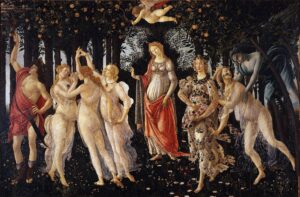
Primavera by Botticelli
Primavera was painted between 1477 and 1482, and it is believed to have been created for the wedding of Lorenzo di Pierfrancesco’s cousin, Giuliano di Piero de’ Medici. The painting was originally located in the Villa di Castello, a country estate owned by the Medici family.
At the center of the painting are seven figures from Greek and Roman mythology, each with their own symbolic significance. From left to right, they are Zephyr (the god of the west wind), Chloris (the goddess of springtime), Flora (the goddess of flowers), Venus (the goddess of love), the Three Graces (representing beauty, charm, and joy), and Mercury (the messenger of the gods).
The painting is rich with symbolic imagery, and each figure represents a different aspect of springtime. The trees and flowers in the background represent the abundance of nature during the spring season, while the orange grove in the upper left corner symbolizes fertility and abundance. The garden is also filled with myrtle bushes, which were associated with love and marriage in Renaissance Italy.
Annunciation by Leonardo da Vinci
Leonardo da Vinci is known as one of the most brilliant minds of the Renaissance era. Along with his notable works such as the Mona Lisa and The Last Supper, da Vinci’s Annunciation is another masterpiece that captivates art enthusiasts to this day. This article explores the story and significance behind Annunciation, its composition, and its impact on the art world.
Annunciation is a painting that depicts the angel Gabriel announcing to the Virgin Mary that she has been chosen to bear the son of God. The scene is set in a Renaissance-style garden, with Mary seated in front of a book, and the angel Gabriel appearing before her. The painting captures the moment of the angel’s arrival, as he approaches Mary with a gesture of greeting and carries a lily in his hand, which symbolizes purity.
The composition of Annunciation is characterized by its use of perspective, which gives the painting depth and creates a sense of spatial realism. The painting is divided into two distinct spaces: the garden and the room. The garden is seen through a window in the background, while the room is in the foreground. Mary is situated in the room, in front of a table with a book on it. The angel Gabriel is depicted outside, peering in through the window.
The painting also incorporates a variety of naturalistic elements, such as the intricate patterns of the flowers and the folds of Mary’s dress, which adds to the overall realism of the painting. The use of light and shadow in the painting is also notable, as it adds depth and a sense of atmosphere to the scene.
Tips for Visiting
- Plan ahead: Allocate plenty of time to explore the vast collection of the Uffizi Gallery. Ideally, set aside at least half a day to fully appreciate the masterpieces on display.
- Wear comfortable shoes: The gallery is extensive, and you’ll likely be on your feet for several hours. Opt for comfortable footwear to ensure a pleasant visit.
- Be prepared for security checks: The Uffizi Gallery has strict security measures in place, so be prepared for bag checks and possible delays when entering the museum.
- Take breaks: Don’t hesitate to take breaks during your visit. The gallery’s courtyard and café offer ideal spots to relax and recharge before continuing your exploration.
The Uffizi Gallery is undoubtedly one of the most important art museums in the world, offering visitors an unparalleled journey through Italian art and history. With its breathtaking collection of masterpieces and stunning architecture, the Uffizi is a must-visit attraction for anyone traveling to Florence.


